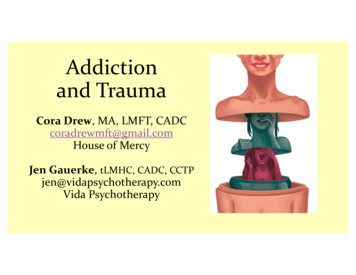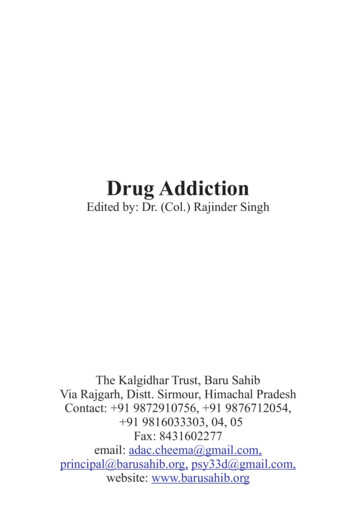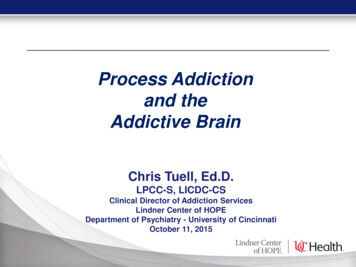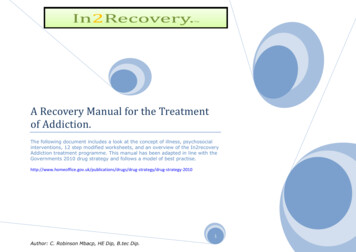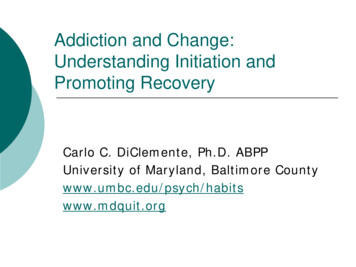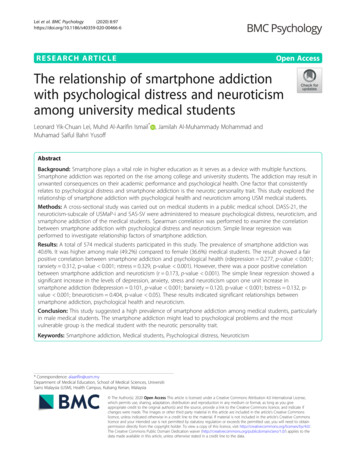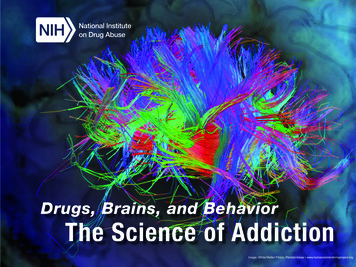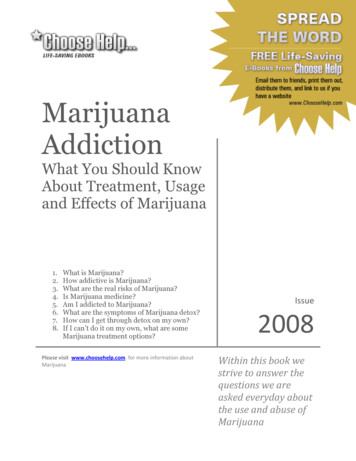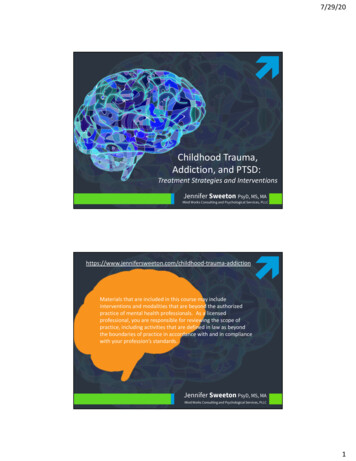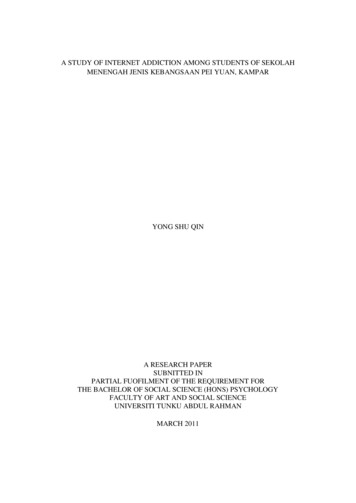
Transcription
A STUDY OF INTERNET ADDICTION AMONG STUDENTS OF SEKOLAHMENENGAH JENIS KEBANGSAAN PEI YUAN, KAMPARYONG SHU QINA RESEARCH PAPERSUBNITTED INPARTIAL FUOFILMENT OF THE REQUIREMENT FORTHE BACHELOR OF SOCIAL SCIENCE (HONS) PSYCHOLOGYFACULTY OF ART AND SOCIAL SCIENCEUNIVERSITI TUNKU ABDUL RAHMANMARCH 2011
ACKNOWLEDGEMENTSI would like to express gratitude for the coaching, guidance and input fromseveral special individual. Firstly, I would like to thank Ms. Low Sew Kim, mysupervisor for all the directions, guidance and advice given that ensure the completionof this project. Next, I would like to my family, especially my parents, Yong ChongKim and Liew Moi Pong and also my sister, Yong Seok Ting for all the moral supportgiven during the stressful periods.I would like to thank Ms. Angeline Goh Lee Ying for the guidance of SPSSprogram. I would like to give special thank to my senior Sebastian Ong for guidanceme in this study and sharing his experience, which has helped me to open my eyesand explore various possible. I would like to thank my friends, Low Yew Kong,Joshua Teo, and Wang Hui Ni for their continuous support and wise counsel that Ivalue and appreciate immeasurably.I also would like to thank the principal of SMJK Pei Yuan for giving mechance to distribute survey forms to students. I would like to express gratitude for allthe participants of this study for their willingness to participate in this study and alsofor their patience during data collection. Last but not least, I would like to thank Godand Jodie for making it all possible for me.To each and every one of you, thank you very much.YONG SHU QIN
Approval FormThis research paper attached hereto, entitle “A Study of Internet Addiction amongStudents of Sekolah Menengah Jenis Kebangsaan Pei Yuan, Kampar” preparedand submitted by “Yong Shu Qin” in partial fulfillment of the requirement for theBachelor of Social Science (Hons) Psychology is hereby accepted.SupervisorMs. Low Sew KimDate:
ABSTRACTThere are many studies about internet use and internet addiction and it is one of thethings that influence our daily life. This study examines the internet addiction insecondary school. The sample consisted of 120 students in Sekolah MenengahKebangsaan Jenis Pei Yuan Kampar, Perak. The study utilized an instrumental tomeasure the internet addiction; namely Internet Addiction Test (IAT). Demographicfactors (age, gender and grade of level) were examined too. Data analysis includeddescriptive and inferential statistic (Chi-square and T-test). The result suggests thatthe level of internet addiction among SMJK Pei Yuan is moderate and tends tominimal. Moreover, there is a significant of gender difference in internet addiction, t(118) 2.380, p 0.019. However, there is no significant association betweeninternet addiction among the lower and upper secondary students of SMJK Pei Yuan,Kampar, x2 (1, n 120) 0.306. It is recommended that problem of internet addictionshould be aware to prevent growing of internet addiction.DECLARATION
I declare that the material contain in this paper is the end result of my own work andthat due acknowledgement has been given in the bibliography and references to ALLsources be they printed, electronic or personal.Name: Yong Shu QinStudent Id: 0802518Signed:Date: 18th March 2011
TABLE OF CONTENTPageABSTRACTiDECLARATIONiiLIST OF TABLEviLIST OF FIGUREvCHAPTERSIIIIIIIVINTRODUCTION1Background of Study1Statement of Problem5Significant of Study6Objective of Study7Research Questions7Hypothesis8Definitions of Concepts8LITERATURE REVIEW10Level of Internet Addiction in Adolescent10Gender Differences in Internet Addiction12Theoretical Framework of Internet Addiction15Symptom of Internet Addiction18Causes of Internet Addiction18METHODOLOGY20Research Design20Subject20Instrument20Research Procedure21Data Analysis21FINDING AND ANALYSIS23Hypothesis 1: Level of Internet Addiction23Hypothesis 2: Gender Differences between Internet Addiction25Hypothesis 3: Significant Association betweenInternet Addiction and the Lower
and Upper Secondary SchoolStudents.V27DISCUSSION AND CONCLUSION29Discussion29Limitation of Study33Recommendation for Future Study34Conclusion35REFERENCES37APPENDIX AQuestionnaire43APPENDIX BJournal Support for Questionnaire46APPENDIX COverall Data Collection54APPENDIX DResult 157APPENDIX EResult 258APPENDIX FResult 359
LIST OF TABLEPageTable4.1Descriptive Statistic for Internet Addiction among Gender254.2Independent Sample Test for Internet Addiction among Gender264.3Chi-square for Internet Addiction between Lower and UpperSecondary Students4.427Chi-square for Internet Addiction between Lower and UpperSecondary Students28
LIST OF FIGURESPageFigure2.1Conceptual Model of Internet Addiction4.1Level of Internet Addiction among Students of SMJKPei Yuan, Kampar1623
CHAPTHER IINTRODUCTIONBackground of StudyInternet is being integrated as part of our everyday’s life because the usage ofinternet has been growing explosively worldwide. Homes, schools, colleges, librariesand internet cafes are the places which are more accessible to internet nowadays.Completing schoolwork, playing online games, reading and writing emails andengaging in real time chatting are the common online activities. According to theNational Center of Education Statistic preliminary studies had shown that a largenumber of American children and adolescents with age around 5 to 17 years old haveaccess to the internet and are exposed to the internet at a very early age (Mythily, Qiuand Winslow, 2008).Young (2006) stated that internet is one of the things that influence our dailylife because internet users more likely to spend their leisure time in the cybercommunity. According to the Ministry of Information and Communication (2005),around 94.8% of teenagers are using the internet and this propensity suggests thatteenagers may consider the cyber space as a real rather than virtual space (as cited inYoung, 2006). Again according to Young 2006, “the internet has Janus face”. Itmeans that internets provide facility for people while on the other hand people mightabuse the internet usage also. Based on Ko et al. (2006) studies that internet andcomputer usage have become popular worldwide but also have negative impact onsome individuals and on society at large.
According to Young (1996), addiction to the internet is the same as addictionto gambling, drugs, and alcohol. Widyanto & McMurran (2004) have explain thatconcept of addiction is quite hard to define because it depends on a substance oractivity. The characteristic of dependence are overindulgence, tolerance, withdrawal,craving, and loss of control. The behavioral addiction has been grown and related tothe use of machines such as playing video games, using computer, and playingamusement machines. Behavioral addictions do not rely heavily on physiologicalmechanisms but most important the psychological explanations of addiction fore.Internet addiction has received increased attention due to the controversialnature and the possibility that a new kind of compulsive activity is on the rise(Mythily, Qiu & Winslow, 2008). According to Chebbi, Koong & Liu (n.d.), Internetaddiction is a contemporary problem brought by easy access to computer and onlineinformation. On the other hand, internet addiction can be defined as an impulsedisorder. Furthermore, some of the characteristic of this problem are similar to thoseof pathological gambling. Orzack (1999) have conducted a study and found thatpeople who are easily bored, lonely, shy, depressed and suffering from other addictionare people who are susceptible to internet addiction (as cited in Chebbi, Koong & Liu,n.d.).Chebbi, Koong & Liu (n.d.) have stated that, people who are addicted tointernet can develop many types of disorder and one of the disorders that are commonfor the modern day is Internet Addiction Disorder (IDA). Individuals who aresuffering from IDA can exhibit symptoms such as drawbacks and face consequencesthat are similar to individual who are addicted to alcohol, gambling, shopping or othercompulsive behaviors. The two major treatments available to help people in thisdisorder are: Cognitive Behavioral Therapy (CBT) and Motivational Enhancement
Therapy (MET).Young (1998), had identified seven reasons for the IDA such asmarital discontent, work related stress, financial problems, insecurity, anxiety,struggle in life, and limited social life (as cited as Chebbi, Koong & Liu, n.d.).There are many studies about internet usage and internet addiction. Tworesearchers, Egger and Rautenberg have worked out a questionnaire to assess usage,feeling and experiences of internet use. When this questionnaire was posted, it andattracted 454 responses and 10% of them were identified as addicted. While the othersurvey: Internet Usage Survey with 32-item true-false questionnaire had been postedby Brenner and received 563 responses. Besides that, Petrie and Gunn had conductedanother online study with 27 questions about the participants’ internet use, attitudes,and beliefs and yielded 455 valid responses. The result has shown that 46.1% of themclassifying themselves as addicted to the internet. Another two assessments are alsocompleted by respondents which are Beck’s Depression Inventory and Eysenck’sIntroversion/ Extroversion Scale. In these both assessment, it is found that the highinternet usage and both depression and introversion indicating that those who considerthemselves addicted to the internet were more likely to be depressed and introverted.Internet Addiction Test (IAT) was posted by Young with 20-item. This is the latestversion for Young and more systematically (Widyanto & McMurran, 2004).According to American Psychiatric Association (1995), the term “addiction”does not appear in the most recent version of the (Diagnostic and Statistical ManualFourth Edition) DSM – IV (as cited as Chebbi, Koong & Liu, n.d.). In additional,another study has mentioned that internet addiction is not a DSM-IV diagnosis yet(Mythily, Qiu and Winslow, 2008). However in 1998, Young have proposed a set ofcriteria for diagnosing internet addiction based on the DSM-IV criteria for
pathological gambling. Young have selected eight out of ten criteria that she felt thatcan applied most readily to internet use:1.Preoccupation of the internet.2. A need for increase time spent online to achieve the same amount ofsatisfaction.3. Repeated efforts to curtail internet use.4.Feel irritability, depression, or mood liability when internet use is limited.5. Staying online longer than anticipated.6. Putting job or relationship in jeopardy to use internet.7. Lying to others about how much time is spent online.8. Using the internet as a means of regulating mood.Individuals fulfill five of the eight criteria would be considered as internet dependence(as cited in Yellowless & Marks, 2005).According to Salman & Hasim (2009), Internet usage in Malaysian beganaround 1992 and they started with simple browsing and e-mail experience and nowturned into mechanism to creatively propagate information. Radio and television hasovertaken by internet as a source of information and par with newspaper. In Malaysia,in order to break through the barrier of gender discrimination, disability, and find job,the women internet users have used information and communications technology(ICT) to allow them to work from home. Sanders (2005) stated that, the number ofMalaysian Internet user has increased over the years reaching 51.4% making Malaysiawomen a force to reckon with far as internet use is concern. Based on Hoffman et al.(2004), internet has exceeded the adoption rate that of earlier mass communicationtechnologies by several magnitudes (as cited in Salman & Hasim, 2009).
However, according to Wong (2010), internet addiction is already a crisis inmany developed countries. He believed this plague has infected youngsters inMalaysia and situation will be worsening by the day. Wong has stated that, it is timefor Health Ministry in Malaysia is to work with psychologists in considering aninternet rehabilitation program because it’s help to bring addicts back into the realworld.Statement of ProblemAs the usage of the internet is growing rapidly each year and internet addictionis becoming a problem among some users. Addicted persons may come from allwalks of life and as a result there are suffering in the main aspect of everyday life inthe situation such as school, family, work and relationship (Chebbi, Koong & Liu,n.d.). In 2007 it was declared that there were 6.6 billion people in the world but 20%of them use internet, the increased rate has increased 265.6% (Canbaz, Sunter, Peksen& Canbaz, 2009). However, 11.67 – 19.8% of adolescents have developed anaddiction to internet use. Indirectly, it impairs the individuals’ psychological wellbeing, peer and family interaction and of course academic performance (Ko at al.,2005).According to Mythily, Qiu and Winslow (2008), Singapore is a multiculturalcity-state with a total resident population of just over 3.5 million people, the literacyrate of Singaporeans is 95.4%. Result show that 84% of the resident with age 10 to 14years age have started to use the internet, while the internet use for the age of 15 to 59is 64%. Besides that, 21% of Singaporean with 60 years and older age group has used
the internet. Furthermore, 78% of household in Singapore have at least one computerno matter is desktop or laptop at home and the 71% of household have access to theinternet at home. The most important thing is 61% of the individuals are using theinternet for leisure activities including playing/downloading games, listening to musicor watching films.According to Canbaz, Sunter & Canbaz (2009), among the 70.6 billionpopulations in Turkey, 22.5% of them use internet in 2007 and usage rate increased to700% between the year of 2000 and 2007. However another study have showed thatapproximately 20 million internet users at the end of 2007 and the amount haveincreased to 26 million by September, 2008 in Turkey (Kabakci, Odabasi & Coklar,2008). Based on Ju et al. (2008), Taiwan has established that 19.8% of adolescentshave internet addiction and they usually have problems with their daily routines,school performance, family relationship and mood.As a conclusion, the studies of internet addiction have been found in manydifferent countries such as western country, Turkey, Taiwan, Hong Kong, Korea,Singapore, and etc. However, this study in Malaysia is very limited and the levels ofinternet addiction among adolescent still in a question mark.Significant of Study.This study is very important to investigate the seriousness of internetaddiction in the society nowadays especially for adolescent in secondary school.Internet is very useful for user to find information for their current work. Howeverpresently internet is not only use for seeking information but being use to fills leisure
time as well. If this phenomenon continues without any solution then internetaddiction will become very serious and serious. So to investigate the seriousness ofthe internet addiction is the main thing to start so that this problem can be solve.Hence this study seeks to find out how serious internet addiction among schoolstudent is.This study also will explain the negative consequences of internet addiction.Besides that these studies also important to let the people who are involve to take careof it such as parents and teacher. Through this study, they may start to aware of thisproblem so that can try to control their children or student.This study can provide much information about internet addiction. This studycan provide information on the symptoms of the internet addiction, the impact ofinternet addiction and also the effect of internet addiction. The important effect thatneeds to be investigating in this study is whether the internet addiction will affect theacademic performance of student in secondary school. However, According to Joeng(2005), internet addiction is significantly and negatively related to students’ academicperformance (as cited as Young, 2006). Besides that, academic performance of thestudents is impaired by the addiction to the use of the internet.Objectives of StudyThere are four objectives in this study. Firstly, the objective for this study is tofind out the seriousness of the internet addiction among students from secondaryschool. SMJK Pei Yuan Kampar’s students will be this study’s population. Thesecond purpose for this study is to investigate what is the level of internet addiction
among them. Besides that this study also wants to investigate whether there is genderdifference in internet addiction. The fourth objective in this study is to investigatewhere the in a difference on internet addiction between lower and upper secondaryschool students in SMJK Pei Yuan Kampar.Research Questions1. What is the level of internet addiction among students of SMJK PeiYuan, Kampar?2. Is there any difference between gender and internet addictionamong students of SMJK Pei Yuan, Kampar?3. Is there any significant association between internet addiction andlevel of study lower and upper secondary school students amongstudents of SMJK Pei Yuan, Kampar?Hypothesis1. The level of internet addiction among students of SMJK Pei Yuan,Kampar is high.2. There is a difference between gender and internet addiction amongstudents of SMJK Pei Yuan, Kampar.3. There is no significant association between internet addiction andlevel of study lower and upper secondary school students amongstudents of SMJK Pei Yuan, Kampar.
Definition of ConceptAddiction.Soule, Shel, & Kleen (2003) concluded that:Mosby’s Medical, Nursing & Allied Health Dictionary definesaddiction as “compulsive, uncontrollable dependence on a substance,habit, or practice to such a degree that cessation causes severeemotional, mental, or physiologic reactions.” According to GaleEncyclopedia of Medicine, “Addiction is a dependence, on a behavioror substance that a person is powerless to stop.” Merriam-Webster’sCollegiate Dictionary defines compulsion as “an irresistible impulse toperform an irrational act” and addiction as a “compulsive need for anduse of a habit-forming substance.” The term addiction has been tosome extent replaced by the word dependence for substance abuse (p.64).Internet addiction.Based on Center for Internet Addiction Recovery,internet addiction is when an individual is having a compulsive behavior involving theinternet interferes with normal functioning, and causes stress on the addicts, as well astheir family, friends, and loved ones (Padwa & Cunningham, 2010). According toWolfe (2000), internet addiction is a creation of the media. While, Bidgoli (2004)stated that, internet addiction is a dysfunctional internet use pattern. This phenomenonoccurs when people spend much time online to the detriment of their social andfinancial well-being.Lower secondary school.Lower secondary school is a compulsoryeducation for children between the age of 12 and 15. Most of the lower secondaryschools are public schools, which are established by municipalities and operated by
local boards of education under national guidelines and legislation (Smith, 1999). Thefirst is ideology, it is actually classical, subject-centred and vocational. Thecurriculum design is subject-centred too. However, for the preferred pedagogy it issubject-focused with much use of textbooks and teacher-prepared worksheets, feweropportunities for fieldwork. The teachers’ characteristics are specialist, trainedprincipally (Tibury & Williams, 1997).Upper secondary school.According to Lee (2002), Upper secondaryeducation is start from Secondary Year Four and Secondary Year Five and is thedemocratization of education or the universalization of education in Malaysia. Thisdemocratization of secondary education has brought about the transformation from anelitist to a universal or mass secondary education. Furthermore, it is the contention ofthis paper that the widening of formal access to education may not lead to real accessto education if effective measures are not put in place. In addition, access to educationmust lead to better equality and quality of education (as cited in Tan, 2010).CHAPTHER IILITERATURE REVIEWLevel of Internet Addiction in AdolescentAccording to Pallanti, Bernardi and Quercioli (2006), Internet addiction can befound at any age and in any social condition, but most of the research major attentionhas been focuses on adolescent because adolescent seem to be a critical period ofaddiction vulnerability. The research of Van Rooij and Van den Eijinden (2007) hadreported that, using internet has become one of the most popular leisure-time
activities among adolescent in Western societies. Adolescents in Netherlands of agesbetween 11 to 15 use the internet for leisure activities and for adolescents aged 14 andolder regard internet usage as an important leisure-time activity than watching TV (ascited as Van den Eijinden, Spijkerman, Vermulst, Van Rooij and Engels, 2009).According to Lin, Lin and Wu (2009), older adolescents appear to be more dependenton the internet than younger adolescent.Recent studies have found that 19.8% of adolescent in the world have internetaddiction and furthermore, it is associated with hostility (Ko, Yen, Liu, Huang, andYen, 2009). The first widely “wired” generation now a day are preteens and teens andaccording to eMarketer (2004), the number of preteens and teens online in UnitedState grew steadily from 26.6 million in 2000 to 34.3 million in 2003 and nearly onehalf of all youngsters were online (as cited in Lin & Yu, 2008). However a recentsurvey from Forrester Research (2005) had revealed that consumer between the age of12 and 17 in North America were often online daily and average almost 11 hours perweek. On the other hand, a survey by Taiwan Network Information Center (2008),should that the internet population in Taiwan has reached 15 million. Among them,internet user of the age under 20 accounted for about 2.86 million. Furthermore, thetwo groups with the highest rates of internet usage were 12 to 15 years old which is98% and 16 to 20 years old that is 95.6% (as cited in Lin & Yu, 2008).Based on Pallanti, Bernardi and Quercioli (2006) research, 5.4% of the samplewas internet addiction and the sample included 275 students with the average of 16.67 1.85 years and consisted of 52.4% males and 47.6% females. This research alsoshown that in Italy, internet usage had a slower diffusion than in other countries.However, in another research from China Internet Network Information Center (2006)had shown that 123 million people had gone online, of which 14.9% were teenagers
below 18 years old and it has concluded that internet addiction is currently becominga serious mental health problem among Chinese adolescents. Chou and Hsiao reportedthat the incidence rate of Internet addiction among Taiwan college students was 5.9%.Wu and Zhu indentified 10.6% of Chinese college students as addicted to Internet (ascited in Cao, Su, Liu and Gao, 2007). Based on Chen et al. (2005), the majority ofonline gaming crime in Taiwan is theft (73.7%) and fraud (20.2) and their researchfound that the age of offenders is low with is 3.3% between ages 15 to 20 years ofage, 8.3% are under 15 years old (as cited in Wan & Chiou, 2007).According to Park, Kim and Cho (2008), there are more adolescent using theinternet than any other age group in South Korea. Based on their research 97.3% ofSouth Korean adolescents between the age of 6 and 19 years used the internet in 2005.Moreover, a study have investigated the prevalence of Internet addiction among SouthKorean adolescents been made. In this study 903 adolescents participated and 10.7%of them scored high on the Internet Addiction Scale and these youths were consideredat high risk for Internet addiction. This phenomenon occurs because South Korea is aninternet-based society that provides numerous middle and high school adolescentswith easy internet access and Internet addiction among South Korean is serious.Gender Differences in Internet AddictionOne of the studies of Hamade (n.d.) showed the distribution of students amongthree levels of internet addiction. It showed that 75.6% of female no sign of addictioncompared to only 46.6% of males. Besides that, less than 25% of females are addictedto the internet and more than 50% of male students are addicted. Moreover, about 18%of males are highly addicted to the internet but females only 6% are highly addicted.In other words, male students are more addicted to the internet than female students
and the reason could be that male students enjoy more freedom than female studentssuch as spend time outside the house and with friends, and visit internet cafes, gamenetworks and other places. This freedom will make them more time surfing theinternet and consequently become more vulnerable to internet addiction.Wartella, Lee & Caplovitz (2002) stated that numerous studies have shown ongender differences in the use of digital media and the type of service girls and boysprefer are different. Besides that, based on (Subrahmanyam et al. (2001); Bickham,Vandewater, Huston, Lee, Caplovitz, & Wright (2003), in early teens, girls use thecomputer longer than boys, but for the late –teens this trends is reversed (as cited inPark 2009). Gender differences in internet addiction can be explained by the types ofcontent that interest men and women. Interactive online games characterized bypower, dominance, control, and violence attract more men than women. As anexample, Young (1998) observed that men tend to seek out dominant activities.Women, on the other hand, seek out close friendships and prefer anonymouscommunication in which they can hide their identity. Van Schie & Wiegman (1997)have another study which showed that boys enjoy online games more than girls. Thispreference makes boys heavy users of the internet (as cited in Park 2009).However, according to Azim, Zam, & Rahman (n.d.) stated that, genderdifferences and trends in age groups are often observed in many study. One of thestudies by Young (1996) showed that middle- aged women were more prone tointernet addiction than men and other age groups. While based on Davis, Smith,Rodrigue and Pulvers (1999) have compared gender differences in internet use. Theyfound that male students spend more time online than female in the public university.However, in private university there was no significant gender differences in tern ofthe time spent online (as cited in Azim, Zam, & Rahman, n.d). One of the studies by
Kubey, Lavin and Barroes (2001) showed that, male students were more internetdependent than women. Dependents were four times more likely than non-dependentsto report academic impairment due to their internet use (as cited in Azim, Zam, &Rahman, n.d).Park, Kim and Cho (2008) concluded that:However, previous studies reported that 4.6% of girls and 4.7% of boyamong 12-18 years olds Finnish youth (Kaltiala-Heino,Lintonen, &Rimpela, 2004) and a total of 1.98% (2.42% for boysand 1.51% forgirls) among Norwegain youth (12-18 years) metcriteria of internetaddiction (Johansson & Gotestam, 2004)(pg.904).According to Hunley et al. (2005) had a report about the amount of time spenton the computer was similar across gender. Tsai and Lin (2004) study, found thatthere was no significant gender difference in adolescents’ Internet self-efficacy, andthey suggesting that both genders were competently mastering it. In another word,both genders appear now to have equivalent resources and experience in accessing theinternet. Although based on this study, gender differences in computer use are narrowbut there is gender gap in online activities and in the content that is accessed (as citedin Lin & Yu, 2008). Mediamark Research (2005) had reported that, boys (28.9%)were more likely to play games than were girls (11.1%). Besides that Griffiths, Davies,and Chappell (2004) also support that boy tended to play games more often than didgirls (as cited in Lin & Yu, 2008). Tsai and Lin (2004) had also stated that, malestended to consider the Internet more as a “toy”, but females tended to view it as a toolor as technology with which to accomplish task (as cited in Lin & Yu, 2008 ). As
previously stated, researchers have found that male and female use internet differently,and according to The Pew Internet and American Life (2005), man are more likelythan women to use the internet more for information gathering while women more touse in communication (as cited in McMahan 2005).The study of Rees and Noyes (2007) found that there are significant genderdifferences that were reported for computer and internet use, internet attitudes, andcomputer anxiety. Although males and females were generally used this technologies,but females are less frequent user of technology as compared to males and thatfemales have less positive attitude and greater aniety toward technology (as cited inAzim, Zam, & Rahman, n.d). However, a study by Ferraro, Caci, D’Amico and DiBlasi (2007) used Italian version of Young’s Internet Addiction Test (IAT). Resultrevealed that no significant differences were found between male and female (as citedin Azim, Zam, & Rahman, n.d)According to Hiroshi and Zavodny (2005) internet use in different location orcountries have different result in gender differences. In the United State Internet use atvarious locations increased over time among women relative to men. In 1997 and1998 were less likely to use internet anywhere or at home but they were more likely todo so by 2001. Nevertheless, women in Japan are much less likely to use the internetthan men regardless of location, and this difference has not narrowed significant overtime. In general, this research had find that gender inequality in labor markets andhuman capital development carries ov
Internet is being integrated as part of our everyday's life because the usage of internet has been growing explosively worldwide. Homes, schools, colleges, libraries and internet cafes are the places which are more accessible to internet nowadays. Completing schoolwork, playing online games, reading and writing emails and

